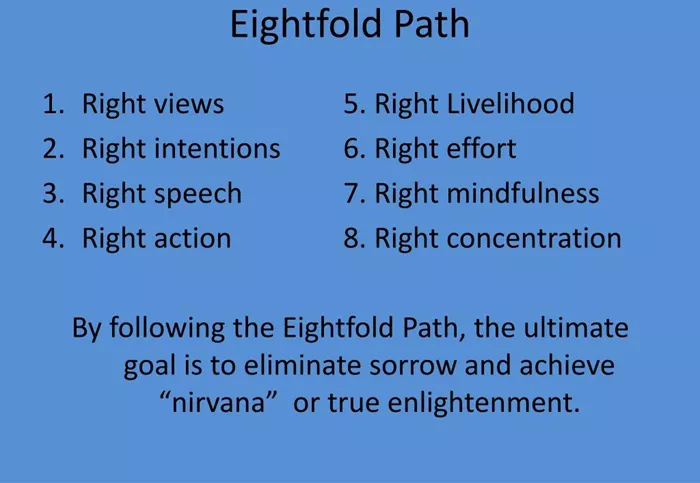The Eightfold Path is a central teaching in Buddhism. It is a guide to living a meaningful and peaceful life. The path consists of eight steps. Each step helps a person develop wisdom, ethical behavior, and mental discipline. The goal is to reach nirvana, a state of complete peace and freedom from suffering.
What Is the Eightfold Path?
The Eightfold Path was taught by Gautama Buddha more than 2,500 years ago. He discovered this path after years of deep meditation and self-discovery. The Buddha found that suffering exists, but it can end by following the right way of living. The Eightfold Path is the practical way to achieve this.
The path is divided into three main sections:
Wisdom (Prajna) – Right View, Right Intention
Ethical Conduct (Sila) – Right Speech, Right Action, Right Livelihood
Mental Discipline (Samadhi) – Right Effort, Right Mindfulness, Right Concentration
Each of these eight steps is important. They are connected and should be practiced together.
1. Right View (Samma Ditthi)
Right View means understanding reality as it is. A person must know that life includes suffering, but suffering has a cause and can end. The cause of suffering is attachment and ignorance. By seeing things clearly, one can follow the right path and avoid harmful actions.
Key points of Right View:
Understanding the Four Noble Truths
Knowing that actions have consequences (karma)
Seeing the world without illusion
2. Right Intention (Samma Sankappa)
Right Intention means thinking in a good and kind way. A person should let go of anger, hate, and selfish desires. Instead, they should focus on love, kindness, and compassion for all beings.
Key points of Right Intention:
Letting go of harmful thoughts
Developing loving-kindness (metta)
Having a peaceful and compassionate mind
3. Right Speech (Samma Vaca)
Right Speech means using words that are true and kind. Words can create peace or cause harm. A Buddhist should avoid lying, gossiping, and speaking in anger. Instead, they should speak with honesty and kindness.
Key points of Right Speech:
No lying or deceiving others
No gossip or harmful talk
Speaking in a way that brings peace and understanding
4. Right Action (Samma Kammanta)
Right Action means doing good deeds and avoiding harmful actions. It follows the principle of non-violence. This means not harming any living being. Buddhists follow the Five Precepts, which guide ethical behavior.
Key points of Right Action:
No killing or harming living beings
No stealing or taking what is not given
No harmful sexual behavior
5. Right Livelihood (Samma Ajiva)
Right Livelihood means earning a living in an honest and ethical way. Some jobs can cause harm, such as selling weapons, killing animals, or dealing with drugs and alcohol. A Buddhist should choose a job that does not hurt others.
Key points of Right Livelihood:
Avoid work that harms people or animals
Choose a job that is honest and helpful
Live a simple and ethical life
6. Right Effort (Samma Vayama)
Right Effort means making a constant effort to improve the mind. Negative thoughts and emotions can appear at any time. A person should work to remove bad thoughts and develop good ones.
Key points of Right Effort:
Prevent bad thoughts from arising
Remove harmful thoughts that already exist
Develop good thoughts and maintain them
7. Right Mindfulness (Samma Sati)
Right Mindfulness means being fully aware of the present moment. Many people live in the past or worry about the future. Mindfulness teaches people to focus on what is happening right now.
Key points of Right Mindfulness:
Being aware of thoughts, feelings, and actions
Practicing mindfulness meditation
Observing the world without attachment or judgment
8. Right Concentration (Samma Samadhi)
Right Concentration means focusing the mind deeply through meditation. It helps a person achieve inner peace and wisdom. With practice, meditation leads to a calm and clear mind.
Key points of Right Concentration:
Practicing deep meditation
Developing a peaceful and focused mind
Reaching higher states of awareness
How to Practice the Eightfold Path in Daily Life
Buddhism teaches that the Eightfold Path is not a list of rules but a way of life. It should be followed every day. Here are some ways to practice it:
Be mindful of thoughts and actions
Speak truthfully and with kindness
Help others and avoid harm
Meditate regularly to develop a clear mind
Make ethical choices in work and daily life
The path is not something to complete in one day. It takes time and effort. With practice, it leads to wisdom and peace.
The Eightfold Path and Nirvana
By following the Eightfold Path, a person can reach nirvana. Nirvana is the end of suffering and the highest state of peace. It means being free from desire, attachment, and ignorance. This is the goal of Buddhism.
Conclusion
The Eightfold Path is a guide to living a good life. It teaches wisdom, ethical conduct, and mental discipline. By practicing right view, intention, speech, action, livelihood, effort, mindfulness, and concentration, one can find peace and happiness.
Buddhism teaches that everyone can follow this path, no matter who they are. With patience and dedication, anyone can move toward a better and more meaningful life.

